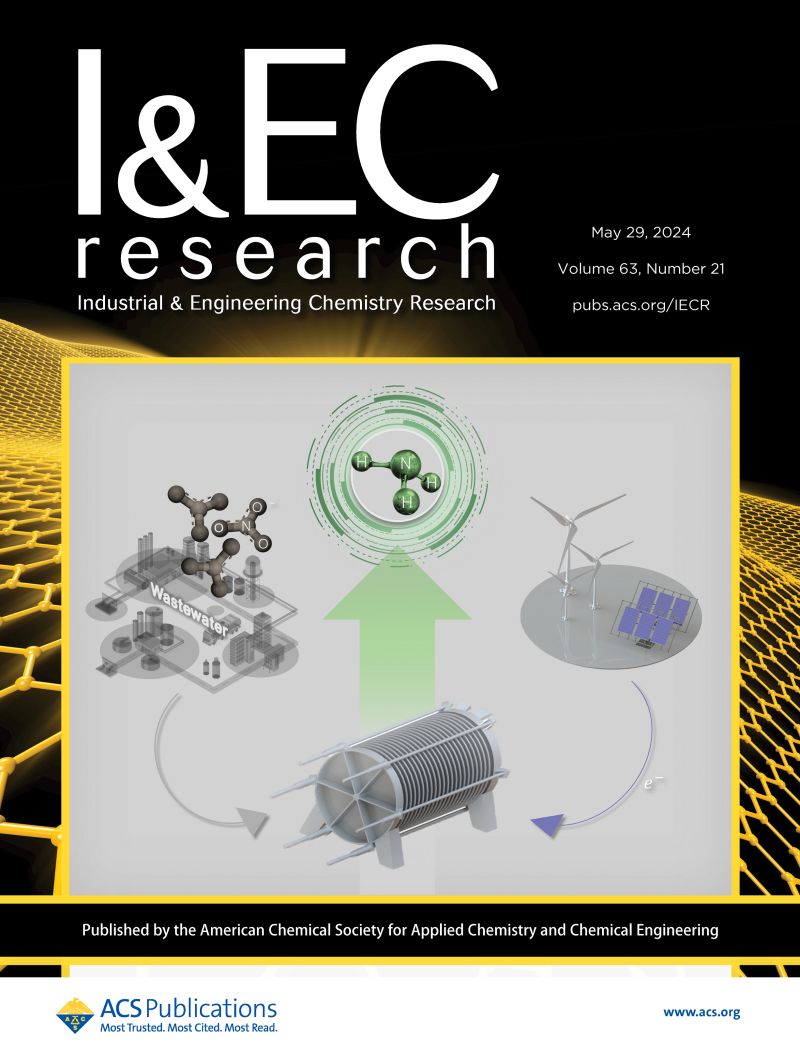一种多功能水煤气联用- COS水解催化反应器的设计与能源经济性优化
IF 3.9
3区 工程技术
Q2 ENGINEERING, CHEMICAL
引用次数: 0
摘要
提出了一种基于模型的方法框架,用于优化在碳质燃料合成气调节过程中发生的催化水气转换(WGS)和COS水解反应,以实现100公吨/天的甲醇生产。采用1D + 1D模型对两个并联固定床反应器组成的传统系统进行仿真,并采用多目标NSGA-II算法对系统进行优化,以达到期望的CO转化率(40%),同时使COS转化率最大化。Pareto-optimal front涉及决策变量,如每个反应器的进料分裂,操作温度,催化剂颗粒直径和数量。实现与期望CO转换的低偏差所需的设计条件导致较低的COS转换。此外,总COS转换主要取决于WGS反应堆的设计。然后对多功能反应器进行了优化,在优化后的单个反应器中可以实现所需的CO和COS转化。低进料温度(220-280°C)和高蒸汽与CO的摩尔比(>0.95)的反应器设计导致高COS转化率,前者归因于平衡限制。与传统的顺序优化相比,进一步进行了多功能反应器的技术经济优化,其中反应器和相关的热交换器网络同时优化。结果表明,从热集成的角度来看,较高的进料温度(283-305°C)是可取的,并且可以消除对热效用的需求。虽然高蒸汽与co比(~ 1)会导致高COS转化率,但也会导致高运营成本。多功能反应器的性能可与传统系统相媲美,但其年化总成本较低。本文章由计算机程序翻译,如有差异,请以英文原文为准。

Co-Optimization of Design and Energy Economics of a Multi-Functional Catalytic Reactor for Combined Water–Gas Shift and COS Hydrolysis
A model-based methodological framework is presented for optimization of catalytic water–gas shift (WGS) and COS hydrolysis reactions that occur during the conditioning of syngas derived from carbonaceous fuels, for 100 metric tonnes/day methanol production. A 1D + 1D model is used to simulate a conventional system of two parallel fixed-bed reactors, and the system is optimized using the multiobjective NSGA-II algorithm to achieve the desired CO conversion (40%) while maximizing the COS conversion. Pareto-optimal fronts involving decision variables such as feed split in each reactor, operating temperature, catalyst particle diameter, and quantity are obtained. Design conditions required to attain low deviation from the desired CO conversion result in a lower COS conversion. Further, the total COS conversion is predominantly dependent on the design of the WGS reactor. A multifunctional reactor is then optimized, and the required CO and COS conversions could be achieved in the optimized single reactor. Reactor designs with low feed temperatures (220–280 °C) and high molar ratio of steam and CO (>0.95) result in high COS conversions, and the former is attributed to equilibrium limitations. Techno-economic optimization of the multifunctional reactor is further performed wherein the reactor and the associated heat exchanger network are optimized simultaneously, in contrast to the conventional sequential optimization. It is shown that higher feed temperatures (283–305 °C) are preferable from the perspective of heat integration and could eliminate the need for hot utility. While a high steam-to-CO ratio (∼1) results in high COS conversion, it also results in high operating costs. The multifunctional reactor is found to yield performance comparable to that of the conventional system, albeit with a lower total annualized cost.
求助全文
通过发布文献求助,成功后即可免费获取论文全文。
去求助
来源期刊

Industrial & Engineering Chemistry Research
工程技术-工程:化工
CiteScore
7.40
自引率
7.10%
发文量
1467
审稿时长
2.8 months
期刊介绍:
ndustrial & Engineering Chemistry, with variations in title and format, has been published since 1909 by the American Chemical Society. Industrial & Engineering Chemistry Research is a weekly publication that reports industrial and academic research in the broad fields of applied chemistry and chemical engineering with special focus on fundamentals, processes, and products.
 求助内容:
求助内容: 应助结果提醒方式:
应助结果提醒方式:


